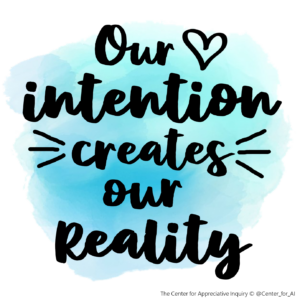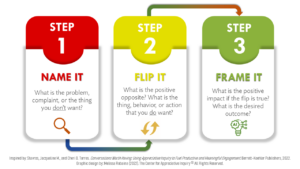This time of year invites reflection. We see the New Year as an opportunity to start anew, to have a clean slate. We assess all facets of our life (i.e., work, family, friends, lifestyle, finances, etc.) and develop a list of resolutions filled with things we wish to improve, build upon, or change in our lives. Yet, by the end of January 80% of us abandon our New Year’s resolutions.
 Experiment this year by making appreciative intentions, rather than setting New Year’s resolutions. You may be thinking, aren’t intentions and resolutions the same thing? While it may seem to be a matter of semantics, there is a significant difference between the two. Resolutions are formulated from a scarcity or deficit-based lens, whereas intentions are created from a place of generativity and strength.
Experiment this year by making appreciative intentions, rather than setting New Year’s resolutions. You may be thinking, aren’t intentions and resolutions the same thing? While it may seem to be a matter of semantics, there is a significant difference between the two. Resolutions are formulated from a scarcity or deficit-based lens, whereas intentions are created from a place of generativity and strength.
Resolutions are courses of action that solve a problem or address an issue and are specific, measurable, and clearly defined. “I want to lose 15 pounds by June” is an example of a resolution. Their specificity, however, means that resolutions often result in “good” or “bad” and “pass” or “fail” mentality. If a person is unable to lose 15 pounds by June, they may consider this resolution a fail and internalize feelings of disappointment and shame and label themselves as “failure” for not reaching what they had set out to do.
Unlike resolutions that contain quantitative measures, intentions are qualitative, embody a quality or value, and create the space for self-compassion and empathy. Intentions consist of a single word or mantra that serves as a guide to inspire action. Similar to the Destiny phase of appreciative inquiry, intentions invite us to experiment, learn, adjust, and grow as we create and live into our desired future.
For example, one year I chose the word “nurture” as my intention. This single, yet powerful, word evoked feelings of hope, excitement, and possibility. As the year progressed and new experiences or challenges surfaced, I leaned into my intention for guidance. Are my decisions, conversations, and actions in alignment with my intention? In moments of uncertainty, I would ask myself questions such as:
– How does (how might) ______________ nurture my love for learning?
– How does (how might) ______________ nurture my desire for growth and self-improvement?
– How might I nurture my relationship with _____________?
– What actions can I take to nurture ____________?
– How can I embody my intention in this moment?
Want to set your intention for the New Year? Below are two exercises to choose from to assist you.
1. APPRECIATIVE INQUIRY
Appreciative inquiry uses storytelling as a way to help people “bring the best of the past into their current reality and project it into their imagined future” (Stratton-Berkessel, 2010). Using appreciative interviews as a guide, individuals share stories, ideas, values, desires, and emotions that illuminate new discoveries for exploration and opportunities for the ideal future.
The questions on the interview guide are carefully crafted in an intensive effort to discover, illuminate, and understand the distinctive values, strengths, practices, and skills present when we are operating at our best.
Experience some of the power of appreciative inquiry by participating in an appreciative interview. Download and print the appreciative interview guide, find an interview partner (i.e., friend, family, colleague), and interview one another.
1. Best Experience. Reflect on the past year through an appreciative lens. Share a story about the best experience you had in creating positive and sustainable change for yourself and/or others. Describe the experience in detail.
a) What is happening? Who was present?
b) What about this experience makes it so memorable?
c) How did your actions, or the actions of others, contribute or enhance this experience?
2. Values. Let’s talk for a moment about some things you value deeply; specifically, the things you value about yourself. For each question, please share a few examples of how you experience or demonstrate those values.
a) Without being humble, what do you most value about yourself – as a person, friend, parent, colleague, etc.?
b) When creating positive change for yourself and others, what core values inspire you to take action?
3. Wishes. What three wishes would you make for yourself that both challenge and inspire you in creating positive and sustainable change in your life?
After all questions have been answered, look for common words, themes, or phrases that appear in the stories. Capture your answers on a piece of paper. Next, review your list. What do you notice? What words do you find most powerful?
Combine the words or themes on your list into a single, powerful word or phrase. The words or phrases that remain can be your intention for the New Year.
2. POSITIVE FRAMING
 Positive framing is intentionally shifting our focus to desirable outcomes. Jackie Stavros and Cheri Torres, co-authors of Conversations Worth Having: Using Appreciative Inquiry to Fuel Productive and Meaningful Engagement, developed a wonderful reframing tool called flipping.
Positive framing is intentionally shifting our focus to desirable outcomes. Jackie Stavros and Cheri Torres, co-authors of Conversations Worth Having: Using Appreciative Inquiry to Fuel Productive and Meaningful Engagement, developed a wonderful reframing tool called flipping.
Flipping creates positive frames for any problem, issue, or challenge and enables you to see positive potential by acknowledging what is, inquiring into what might be, and inspiring action for change. The key to this exercise lies in the question: “What do you really want?” Download and print the flipping handout to practice flipping.
NEXT STEPS...
Once you have selected your intention for the New Year, take a moment to reflect or mediate on your intention. What does it feel like to embody this intention? How might you demonstrate your intention in this moment?
Place your intention where you will see it daily. Make a habit of looking at your intention regularly; this will prompt your subconscious mind to generate new ideas on how you can live into your intention. If you become stuck, some prompting questions include:
• What do I most appreciate about my intention?
• How do my strengths support my intention?
• How might I create more opportunities to live into my intention?
• What new skills or knowledge would further enhance my ability to live into my intention?
Using appreciative inquiry to set our New Year intentions invites us to create new and inspiring images of what we do want in our lives. Research in image theory suggests that the images we hold of the future influence the decisions and actions we take in the present. It implies that one of the most untapped resources for change are the images embedded within our stories and visions of our preferred future.
Be kind to yourself in the New Year. Take time to pause and celebrate small wins as they happen. Celebrating milestones – big and small – is a great way to re-energize and reinforce your intention for the year.
May you have a healthy, happy, and meaningful New Year!
References & Bibliography
Robaina, M. (2022). Intention Creates Reality. The Center for Appreciative Inquiry [Digital Image].
Robaina, M. (2022). Name It, Flip It, Frame It. The Center for Appreciative Inquiry [Digital Image].
Stavros, J. & Torres, C. (2022). Conversations Worth Having: Using Appreciative Inquiry to Fuel Productive and Meaningful Engagement (2nd ed.) Berrett-Koehler Publishers.
Stratton-Berkessel, R. (2010). Appreciative Inquiry for Collaborative Solutions: 21 Strength-Based Workshops (1st ed.). Pfeiffer.


Comments
Add your comment now using your favorite social account or Click Here To Login

@Melissa. I truly appreciate you writing this article; I enjoyed reading it and will share it with friends and colleagues.
Thank you @Jaime for the kinds words. I am so happy that you enjoyed that article. What is your intention for this year?
My intention for the year is captured in one word. SOAR. I am looking at everything I plan to do to ensure that it aligns with my life purpose and elevates it. Thanks for asking.
Thank you Melissa for sharing wonderful ways to invite positivity and compassion into the new year!